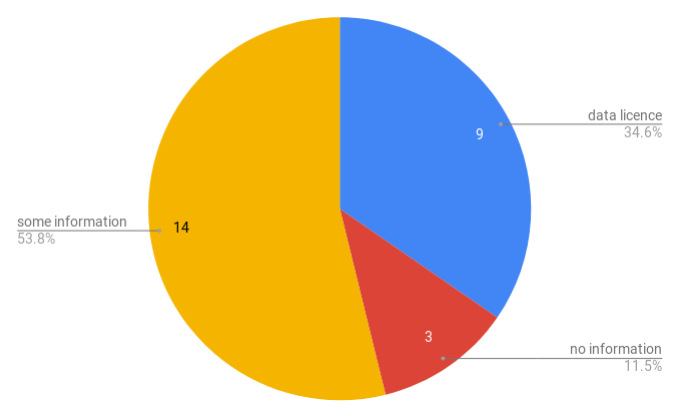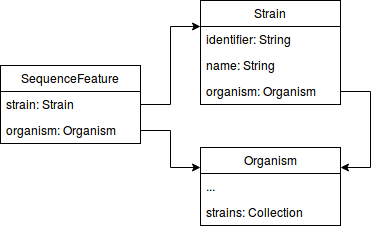Local unique identifiers (LUIs)
A LUI (Local Unique Identifier) is an identifier guaranteed to be unique in a given local context (e.g. a single data collection). [Ref. https://doi.org/10.1371/journal.pbio.2001414]. InterMine’s existing local identifiers are based on an internal database ID; they are unique but they are not preserved across database releases. For example, the ID 1007854 which currently identifies the gene zen in FlyMine, it’s not persistent; after the next build the link http://www.flymine.org/flymine/report.do?id=1007854 will be not valid.
In InterMine, we have implemented new persistent local unique identifiers which are preserved across releases; they are based on the class types, defined in the InterMine core model, and the external IDs from the main data source provider integrated.
Some examples are:
protein:P31946 (protein identifier)
publication:8829651 (PubMed identifier)
gene:MGI:1924206 (gene identifier)
Persistent URIs
An URI (Uniform Resource Identifier) is an identifier which is unique on the web, and not only within the local context as the LUI is, and actionable, so if you copy it in the web address bar you are redirected to the source. URIs need to be persistent in order to to provide reliable sources, always findable and accessible.
Some examples of persistent URIs are:
http://purl.uniprot.org/uniprot/P05455 where P05455 is the LUI for UniProt
http://identifiers.org/biosample/SAMEA104559033 where SAMEA104559033 is the LUI for biosample.
Where are Permanent URIs going to be used by InterMine?
1. To markup the web pages for search engines with Bioschemas.org or Schema.org types: set the identifier attribute with the persistent URI in DataCatalog, DataSeta and BioChemEntity types.
2. To generate RDF: we need persistent URI to set the subject in the triples generated.
We need to generate persistent URIs only if we create new entities. If a mine instance DOES NOT create new entities, it needs to re-use the existing URIs provided by the main source provider.
In FlyMine, for example, the RDF generated for the protein P05455 integrated from UniProt, which is the main resource provider for that data type, should be:
<http://purl.uniprot.org/uniprot/P05455> rdf:type <http://semanticscience.org/resource/SIO_010043> .
<http://purl.uniprot.org/uniprot/P05455> rdfs:label “Protein P05455” .
But how to generate persistent URIs?
There are different options to generate persistent URIs, and the mine administrator will choose the option which is more suitable to the mine instance.
Option 1: Generate Persistent URIs using third party resolvers
In order to provide permanent URIs, we can configure the mine instance to use Identifiers.org as PURL (permanent URI) provider. These the steps to follow:
1. register the mine instance in Identifiers.org as data collection
2. set, in the mine instance, the property identifier.uri.base with the URI assigned by Identifiers.org (e.g. http://identifiers.org/legumemine).
The URI, generated by LegumeMine, for the entity GeneticMarker with primary identifier 118M3 will be: http://identifiers.org/legumemine:geneticmarker:118M3. This is persistent, unique and actionable: if you paste it in the web browser address you will redirected to the navigable URL: https://mines.legumeinfo.org/legumemine/geneticmarker:118M3 by identifiers.org.
Option 2 – Generate Persistent URIs setting a redirection system
A mine administrator might prefer to implement an in-house redirection system (couple of lines in apache or nginx configuration files) setting a purl system similar to purl.uniprot.org.
In LegumeMine, for example, the permanent URI, for the entity GeneticMarker with identifier 118M3 might be: http://purl.legumemine.org/legumemine/geneticmarker:118M3.
Option 3 – Use navigable URLs
A mine administrator might decide to use the navigable URLs (see the next section) as permanent URIs.
An example is given by ZFIN where the URI http://zfin.org/ZDB-GENE-040718-423 coincides with the navigable URL.
Navigable persistent URLs
The navigable or access URLs are the URLs of the web pages where the users are redirected.
Examples of the new navigable URLs in Flymine:
http://flymine.org/flymine/protein:P31946
http://flymine.org/flymine/publication:781465
http://flymine.org/flymine/gene:MGI:1924206
The new navigable URLs will not change at every build! We can guarantee they will be persistent setting redirection system which resolves old URLs.
Navigable URLs usage
1. Permanent link button in the current report page
2. Permanent link button in BlueGenes, InterMine’s new user interface.
3. To markup the web pages with Bioschemas.org type: url attribute will be set with the navigable URL
4. To generate RDF: the field schema:mainEntityOfPage will be set with the persistent URL. For example:
<http://identifiers.org/MGI:97490> schema:mainEntityOfPage <https://mousemine.org/gene:MGI:97490>
The new permanent URIs and URLs have been scheduled to be released in InterMine 4.0 release.




You must be logged in to post a comment.